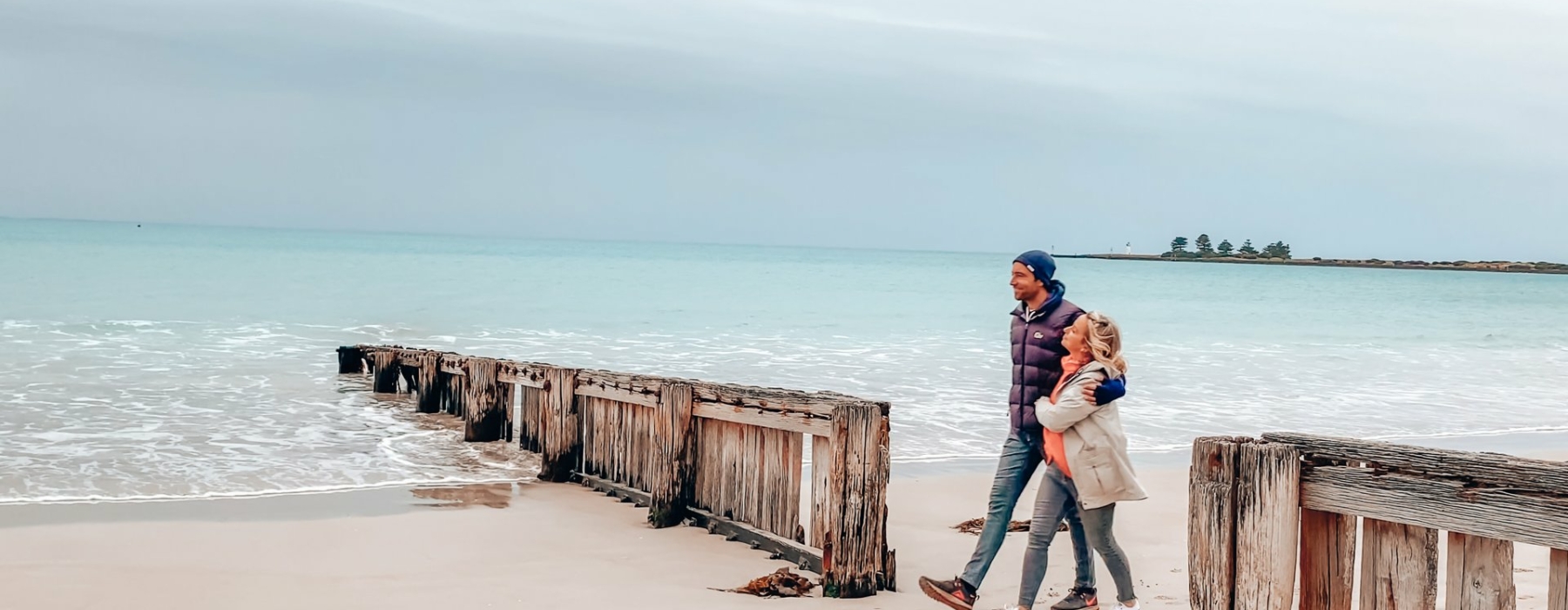
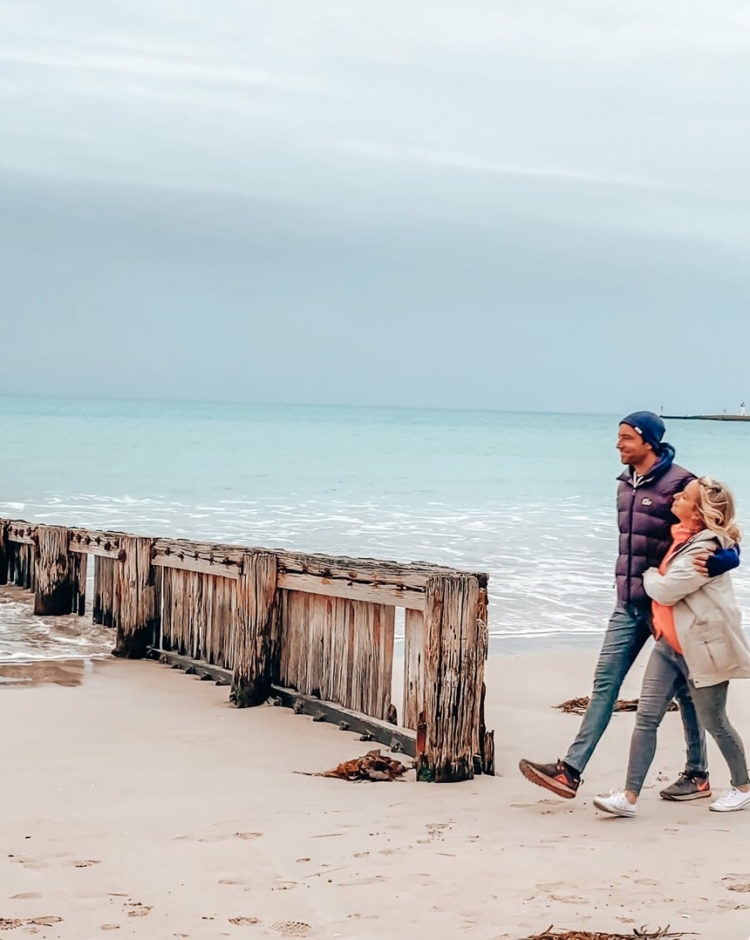
What could be more romantic than being whisked away to the Great Ocean Road’s beating heart?
This charming coastal village is alive with history and modern treasures alike. Hire bikes and cruise along historic streets, lined with 19th Century cottages and Norfolk Pines. Then watch fisherman unload their catch of the day at one of the busiest fishing ports in Victoria. Explore the wildlife sanctuary and historic lighthouse on Griffith Island and keep an eye out for whales on your brisk winter walk on East Beach.
Peruse the local luxury boutiques, antique stores and meet the makers at the artisan workshops scattered throughout this picturesque town. Then relax at some of the finest food and wine destinations on the Great Ocean Road before returning to your unforgettable accommodation at historic bluestone BnB’s.
Nestled on the Northern slopes of the dormant volcano of Tower Hill lies the historic Irish farming settlement of Koroit. This quaint, close-knit village is hailed as one of Australia’s most complete examples of early Irish settlement. Here, Irish charm flows as freely as pints of Guinness.
Venture inland to the UNESCO listed culturally significant landscape of Budj Bim — located in the traditional Country of the Gunditjmara people. The unique lava flow from an ancient volcanic eruption is what created this significant landscape and connects the three main components — the long-dormant Budj Bim Volcano and Tae Rak (Lake Condah), the wetland swamps of Kurtonitj and the rocky ridges and marshes of Tyrendarra. Budj Bim’s system of weirs, channels and volcanic lava flow allowed the Gunditjmara people to create the earliest living example of aquaculture in the world, their history of eel farming dates back over 6,000 years. Hence its UNESCO listing of ‘outstanding universal value’.
Budj Bim is one of only nineteen other locations in Australia that have made the list, and the only Australian World Heritage property listed exclusively for its Aboriginal cultural value.
Drive
Melbourne: Travel the scenic Hamilton Highway via Geelong & Mortlake. It’s approx. 288km and takes around three and a half hours.
12 Apostles: Staying on the Great Ocean Road, travel west to the A1 at Allansford, before travelling through Warrnambool to Port Fairy. It’s approx 100kms and will take you around one hour and fifteen minutes.
Adelaide: Leaving Adelaide along the Dukes Highway, you will turn south at Keith onto the Riddoch’s Highway before arriving at Mt Gambier, here you will turn East onto the Princes Highway driving directly to Port Fairy. The journey will take you approx. six and a half hours and is approx. 575 kms.
Train & Bus
V-Line coach services connect with the Melbourne Rail Network at Warrnambool.
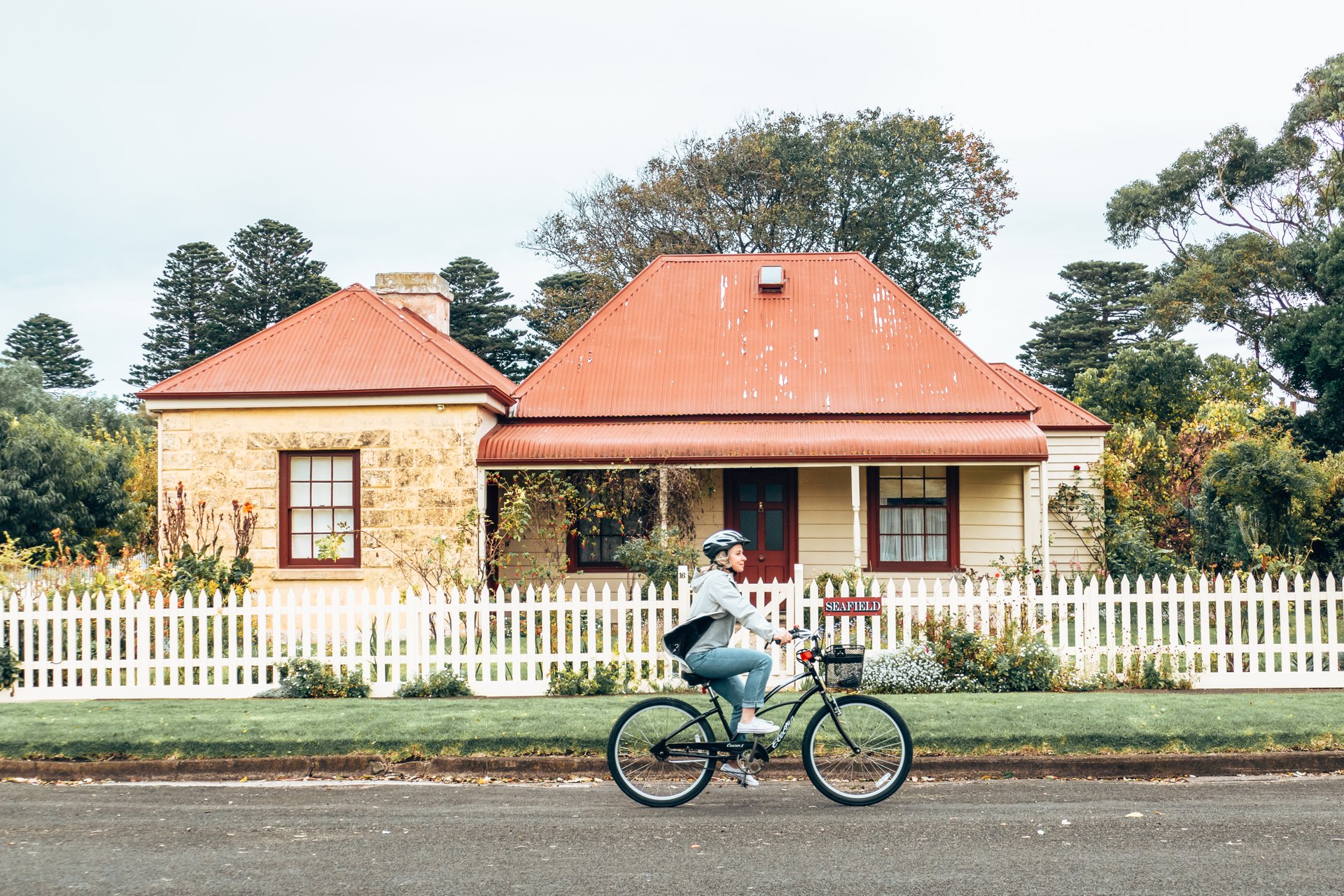
CYCLE PAST VICTORIA’S FRESHEST SEAFOOD
The best way to take in this quaint village is with the salty sea breeze in your lungs and wind in your hair as you cycle the historic streets and boardwalk of the Moyne River. We hired bikes from the Port Fairy Visitor Information Centre and set off to the bustling harbour.
This is one of the busiest ports in Victoria and the local fishermen were already unloading their fresh morning catch of crayfish and abalone. Guided fishing charters can take you out to sea to catch your own if you fancy. Or sit back and take a seat at the water’s edge restaurants for the freshest ‘boat to belly’ fish & chips or seafood platter you can get!
RIDE THROUGH HISTORY
Ride back in time as you cruise down the beautifully preserved streetscapes. The Port Fairy Historical Town Walk provides a great self-guided map (pick one up from the Visitor Centre) then discover over 50 buildings listed with the National Trust. Our favourite dwelling was ‘Seafield’, one of the oldest homes on Wishart St, which dates back to 1852.
HOT TIP: Take a guided History Tour through the Port Fairy Visitor Information Centre; you will have the choice of a Fun with History Town Walk, Wharf Walk or Battery Hill Walk. Can’t decide, book all three!
WORKED UP AN APPETITE
The Mill Cafe were a delight with their fresh savoury and sweet menu. We Sat back to be rewarded by the friendly service, all served up with a big smile, street side as we watch life in this vibrant seaside town go by.
We recommend the gluten free tart, the crispy chicken burger and a milkshake each…. the best chicken we have ever had and the salad and tart were incredible topped with a delicious relish!
BIKE-HIKE THE WILDLIFE SANCTUARY, GRIFFITHS ISLAND
Keep peddling to the trails of the nearby Griffiths Island — you may have to push in some sandy areas. This natural oasis is a sanctuary for native animals including wallabies, blue-tongue lizards, echidnas and over 80 species of birds. It’s also the perfect nesting ground for the Short-tailed Shearwater or ‘Mutton bird’.
Bike the 1.2km return track to Griffith’s Islands’ Eastern tip and discover the historic Port Fairy Lighthouse, built in 1859. This is also a great location for whale spotting from May to September. This local bluestone lighthouse is still operational but today is solar-powered and fully automatic, the last lighthouse keeper left the island in the early 1950s.
VISITING DURING WINTER: This is also a great location for whale spotting from May to September.
THE OAK & ANCHOR HOTEL – THE MOST ROMANTIC OF RETREATS.
We were staying at Oak & Anchor, a 6-bedroom boutique hotel located right in the heart of the seaside village. This historic bluestone building has been a part of Port Fairy’s colourful history since 1857 and was lovingly renovated by owners Blair and Sally in 2018 — now, it’s the classiest old dame in town.
Each suite is uniquely designed mixing the historic stone, timber and rusted steel textures with luxurious, contemporary furnishings right down to the tiniest of details. These luxurious, light filled rooms with open plan bathrooms and decadently deep bathtubs makes for an unforgettable romantic retreat.
LUXURY SHOPPING AT YOUR DOORSTEP
Whilst you are sipping wine from your dreamy bubble bath you might spy the sophisticated shopping strip right across the road. Penny & Reibey, Luone Silversmith jewellery and Golden Store are just a few of the irresistible boutiques that lure shoppers from all along the Shipwreck Coast. I couldn’t resist popping over to check out the designer labels, handcrafted homewares, gorgeous gifts and the bespoke silversmith workshop.
FROM BASS STRAIGHT TO PLATE — A SEAFOOD PLATTER AT THE WHARF
You can’t stay in a famous fishing village like Port Fairy without trying the local goods! We couldn’t go past the relaxed and lively atmosphere of ‘The Wharf’. This iconic Modern Australian restaurant is located on the water’s edge of the Moyne River — only metres from where the local fisherman unloaded their catch only hours ago.
Whether you are looking for classic takeaway fish & chips or to dine in on the innovative, seasonal menu, seafood doesn’t come fresher than this. We ordered the seafood platter for 2 and the chef’s generous assortment of oysters (fresh and Kilpatrick), prawns, cured trout, zesty mussels, garlic scallops and seared salmon exceeded even our wildest expectations. Paired with a bottle of local Riesling it was the perfect way to finish the day.
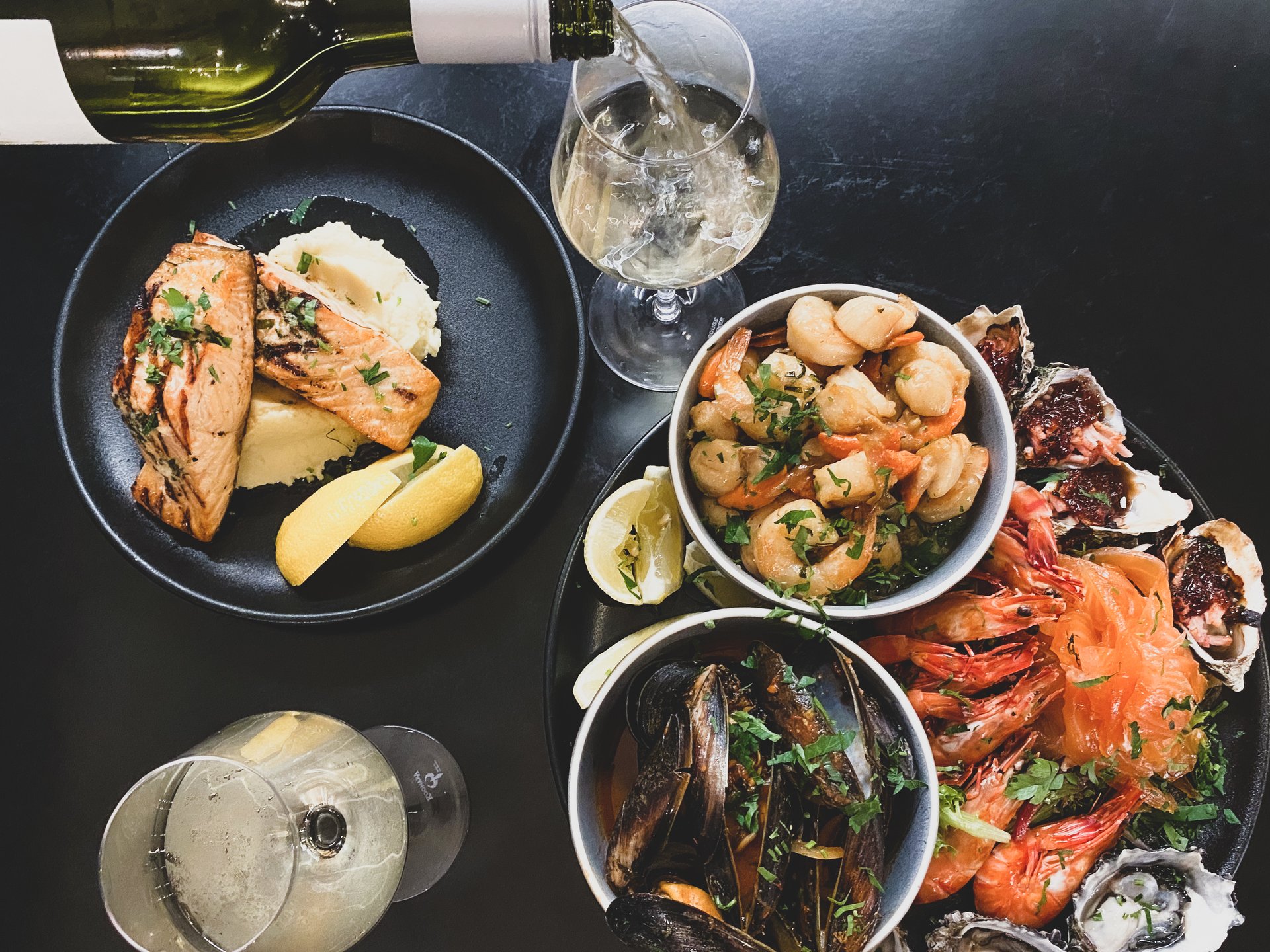

TOWER HILL WILDLIFE RESERVE GUIDED WALK
Tower Hill Wildlife Reserve lies inside a dormant volcano that last erupted over 7000 years ago. The explosion created the enormous 11km crater rim and was thought to be as forceful as 4 atomic bombs. Venture inside the crater for a 90-minute walk with your experienced guide. Exploring the majestic landscape, we learnt of its historical importance and met the wildlife who call the re-vegetated park home. Some of Australia’s most iconic animals live here and if you’re as lucky as us you will see emus, koalas, kangaroos, echidnas and wedge-tail eagles just to name a few.
TOWER HILL VON GUERARD LOOKOUT
If you can’t leave Tower Hill without one last pic there are 3 great lookouts on the rim on the Tower Hill crater. This particular viewpoint was famously painted by Eugene Von Guerard in the 1800s. No wonder he chose this spot — it offers sweeping views of the reserve and the 4 unique volcanic cones that rise from the lake bed, created from smaller eruptions. Thankfully he did, because Von Guerard’s precise painting proved to be an invaluable template for the botanists, conservationists and scientists of the Tower Hill re-vegetation program, helping them to restore this land that had previously been destroyed by land clearing, grazing, fire and mining.
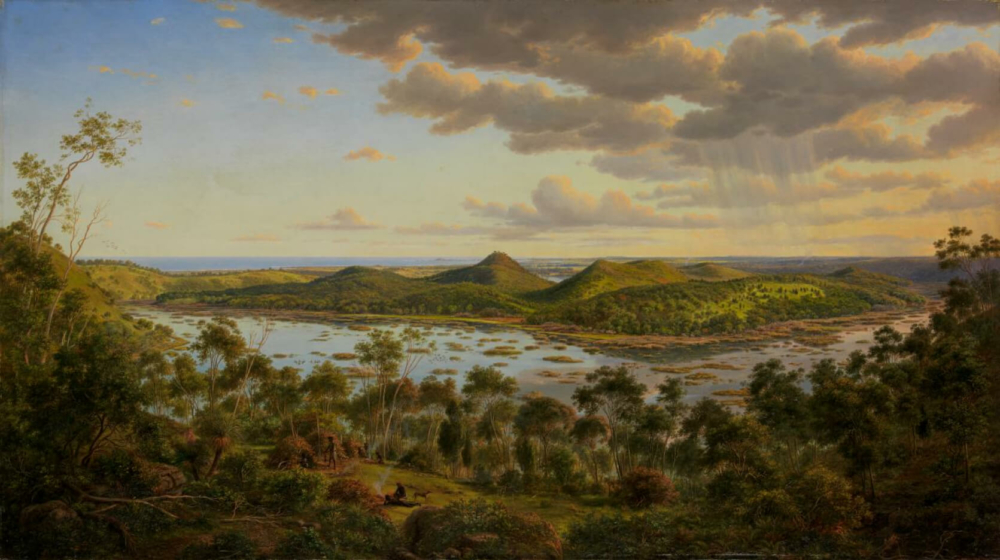
Eugene von Guerard Tower Hill in 1855 Painting – Warrnambool Art Gallery
LUNCH: NOODLEDOOF BREWING & DISTILLING CO
Is it a noodle shop? An outdoor dance party? Even better, it’s a craft brewery, distillery, cafe and event space tucked away in a refurbished motor garage. It was created by two mates Noodles and Doof with a love of making quality, creative craft beer and spirits. The tap list is constantly evolving — with exciting small batch brews and adventurous spirits. Their unique flavour profiles are born from the collaboration with local Aboriginal Corporation, Worn Gundidj using their expert knowledge of the native local botanicals such as correa alba, lemon myrtle and mountain pepper.
The cafe menu and daily specials of this brew-pub are equally exciting and a celebration of produce from the surrounding area and the nearly Southern Ocean. We tucked into a share plate of crab croquettes, a medley of locally farmed carrots followed by a spicy chilli dumpling and noodle soup. A cheeky (and tasty) nod to the pre-opening rumour mill about Noodledoof being a noodle shop.
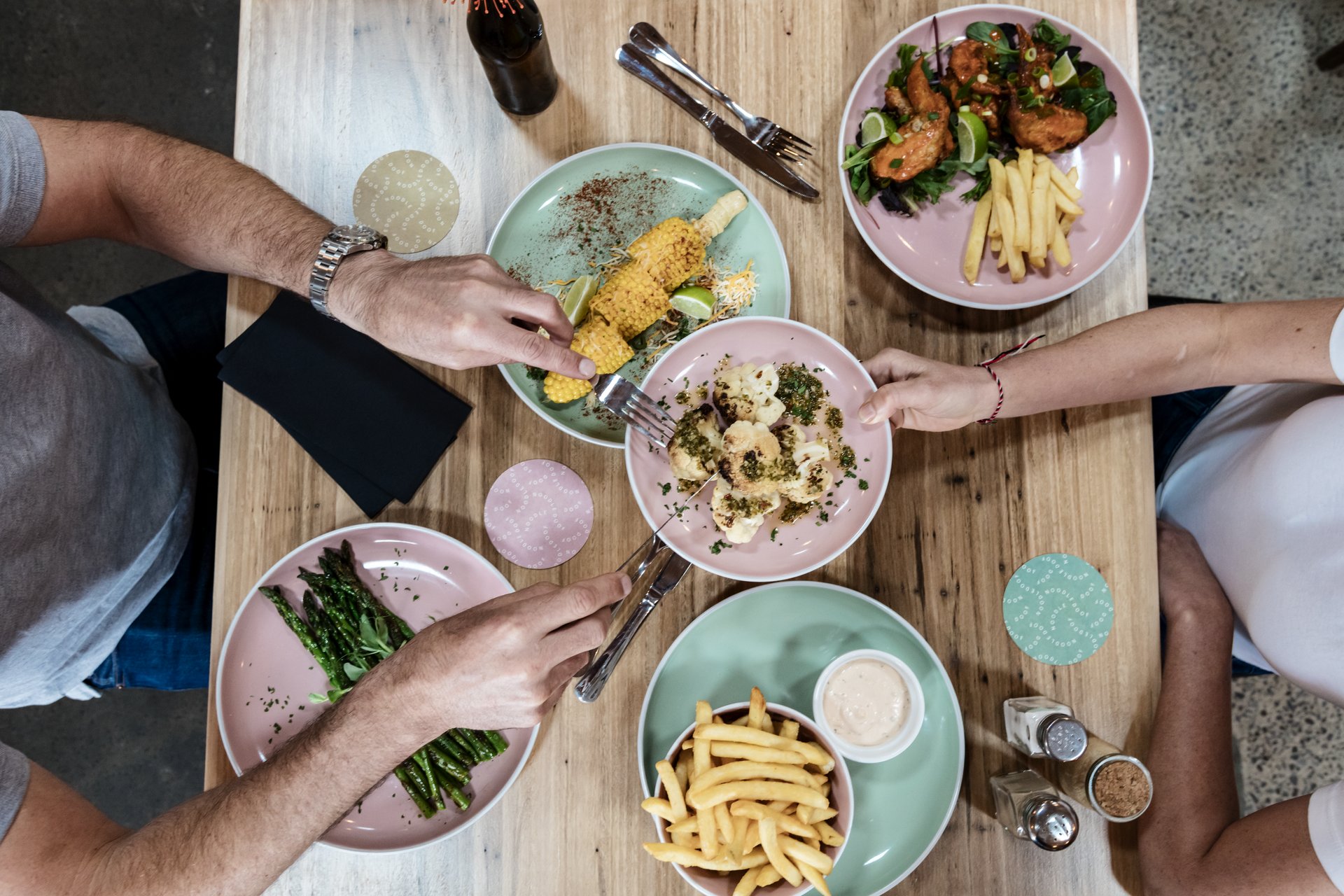
AFTERNOON: MICKEY BOURKE’S ICONIC IRISH HOTEL
This iconic pub is the heartbeat of Koroit’s Irish heritage. And a freshly poured Guinness is the lifeblood that runs through its veins. Since opening its doors in 1853 Mickey Bourke’s has been the local’s favourite meeting place for a good yarn, a pint and a home-style Irish meal. So, grab yourself a beer, pull up a barstool and drink up the charming character of this renowned hotel.
SHARE SOME OF THE REGIONS’ BEST PRODUCE, TAPAS STYLE
Port Fairy is famed for its multitude of dining destinations. But tonight, we don’t have to travel further than downstairs. The Oak and Anchor Hotel team with over 70+ years of combined hospitality experience know how to serve up an exceptional meal, whatever time of day you choose to dine. The three beautifully crafted menus (breakfast, lunch & dinner) show off the best of seasonal and regional produce. The tapas-style share plates of slow-cooked meats and contemporary bite-sized snacks soon turned the meal into a feast!
Luckily, we only had to roll ourselves back upstairs.
MORNING: BUDJ BIM NATIONAL PARK
We woke with first light and set out on a 45-minute drive to explore Budj Bim National Park. Budj Bim National Park, renamed in 2017, (previously known as Mt Eccles National Park) this 8000-hectare national park is the first national park co-managed by Gunditjmara Traditional Owners and Parks Victoria.
EXPLORING THIS UNIQUE VOLCANIC LAND — CRATER LAKES, LAVA BLISTERS AND CAVES
Follow the Lake Surprise walk along the crater rim or descend to walk the Crater Lakes edge. The longer Lava Canal circuit walk will reveal a maze of lava blisters, Tunnel Cave, Natural Bridge and also a dry crater offering views of the park and into the crater itself.
The Lava Canal Walk is a relatively flat, all skill level walk. It starts at the crater of Lake Surprise then follows the path set by the volcanic lava flow all those centuries ago. You’ll weave through lush bushland — the bracken ferns, broken basalt rocks and towering trees make it feel pre-historic! So many native animals call this landscape home, we lost count of the number of kangaroos and wallabies we saw.
Our favourite part of the leisurely 3h walk was following a lava canal that leads into a natural bridge. As you enter the cave it’s like entering the spiritual land itself. The whole week has been unforgettable!
LUNCH: SUFFOIR WINERY
We took our taste buds on the short drive to Suffoir Winery, Brewery & Distillery to treat ourselves to a light lunch amongst the enchanting cottage garden, soaking in the picturesque surroundings to experience animal life!
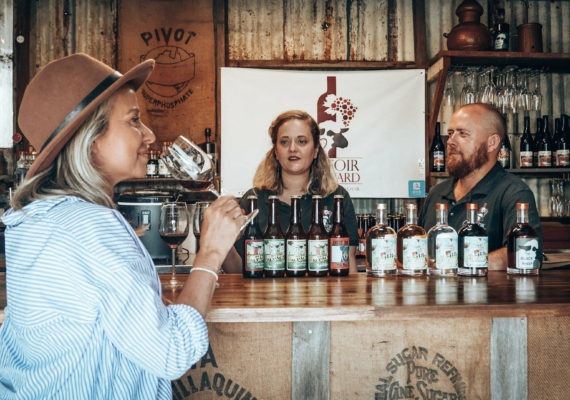
Suffoir is a working farm, housing a micro-winery, brewery, cidery, distillery and cellar door. Their artisanal wine, craft beer, gin, and cider are sustainably produced, with a focus on holistic living. The cellar door is open to the public offering wine tastings, beer paddle tastings, cellar door sales, cheese platters and a range of other services.
WALK WITH GUNDITJMARA PEOPLE ON THEIR CULTURALLY SIGNIFICANT LAND
What better way to complete a short trip than to walk as a guest on Gunditjmara country and experience a culture that is over 60,000 years old. I joined Leigh from Budj Bim Tours for an authentic, guided tour of Tyrendarra, the southern component of the landscape, situated almost entirely within the unique Budj Bim lava flow. These flows helped the Gunditjmara people create the oldest and most extensive freshwater stone aquaculture system in the world.
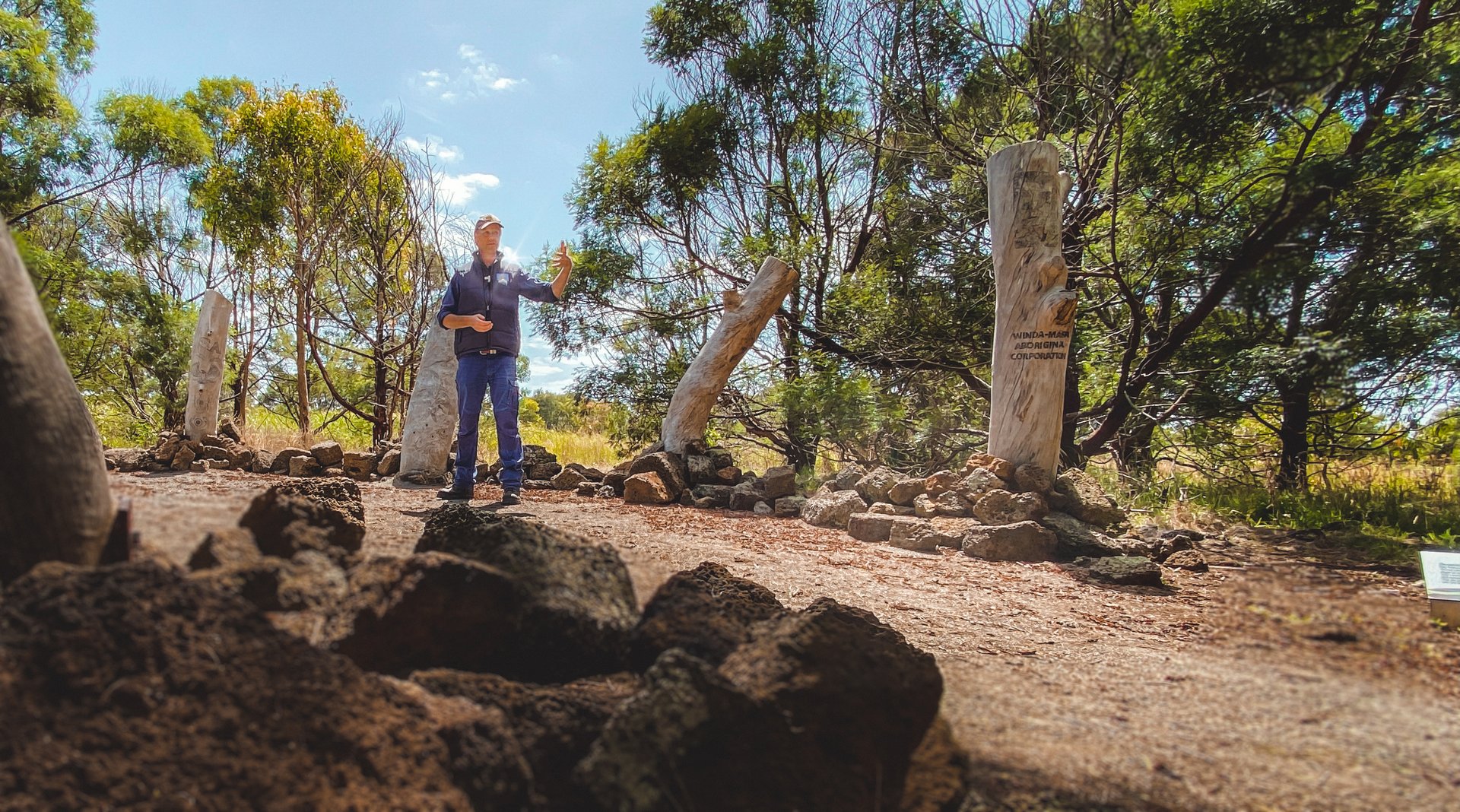
A Gunditjmara descendant Leigh’s 2.5-hour tour offers a never to be forgotten opportunity to experience the history and storytelling of this awe-inspiring landscape through the eyes and voice of a traditional owner. As we roamed the remnants of the circular stone dwellings Leigh explained Tyrendarra’s history as a traditional meeting place and camping area for their people. And that the land is a part of major Dreaming trails and an important ceremonial site since the deep time (a period of at least 32,000 years). As we sat in the very place where creation and dreaming stories have been told for thousands of centuries Leigh told us the Budj Bim creation story.
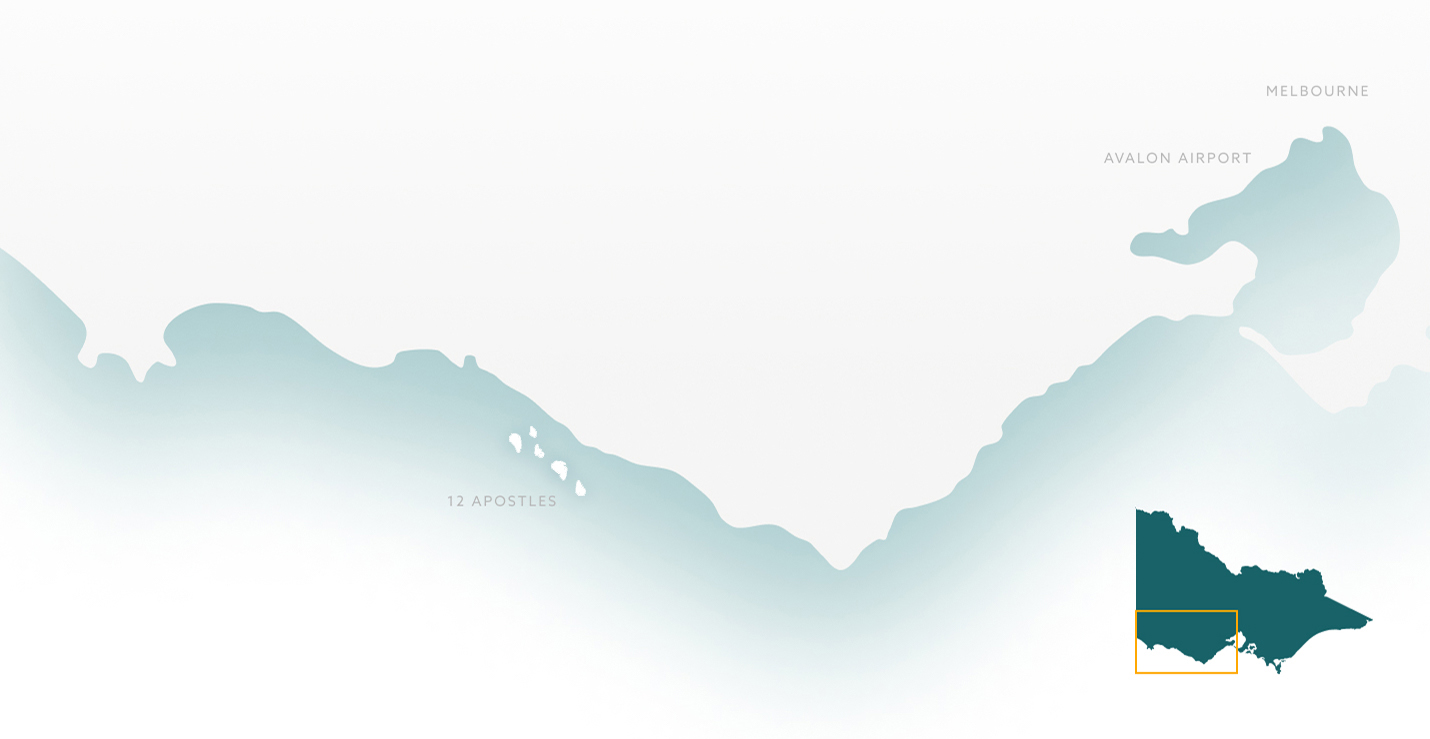
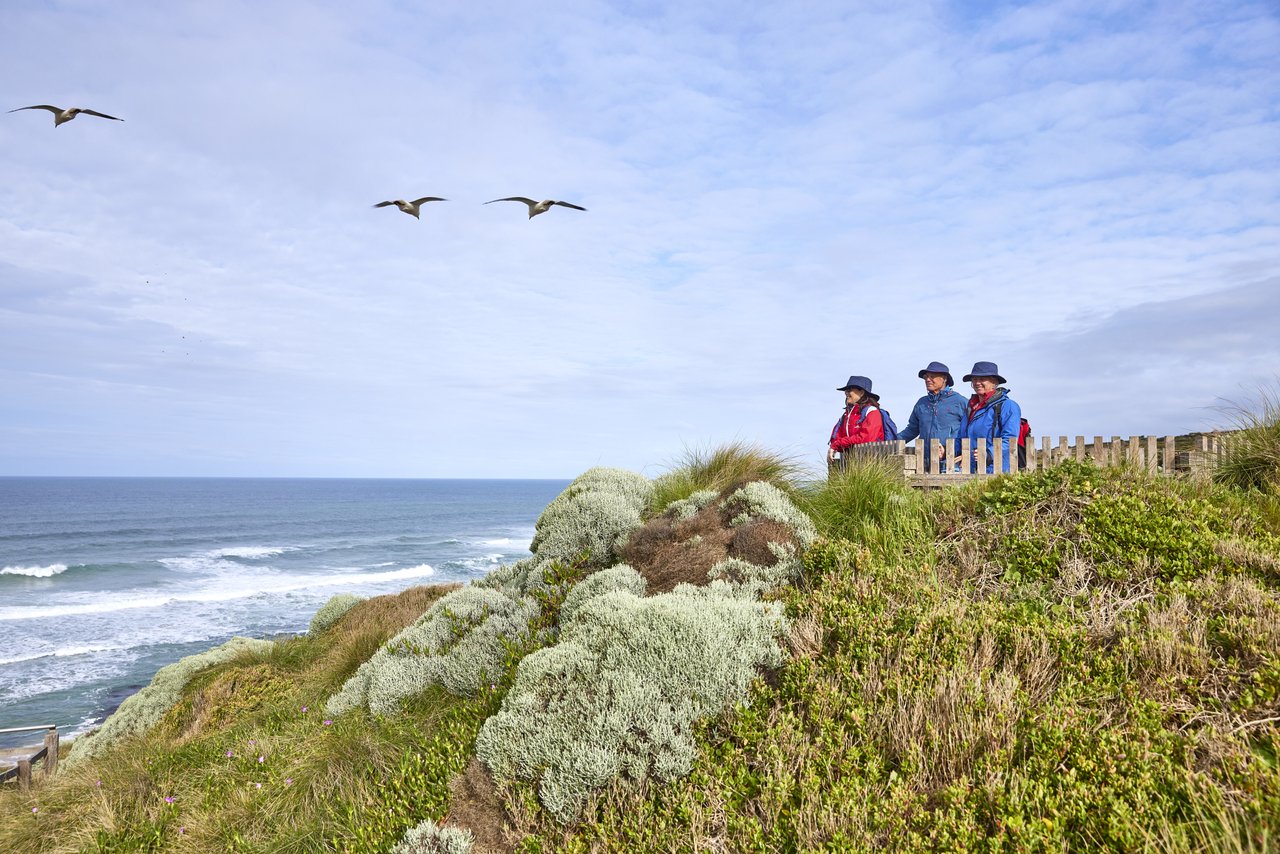
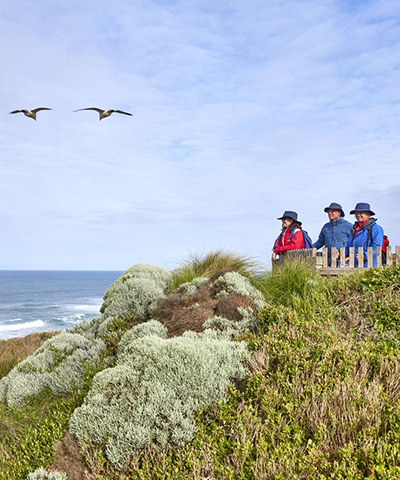
Sign up to get the latest deals, tours & events along the Great Ocean Road
Great Ocean Road Regional Tourism acknowledges the Traditional Custodians of the Great Ocean Road region the Wadawurrung, Eastern Maar & Gunditjmara. We pay our respects to their Elders, past, present and emerging. We recognise and respect their unique cultural heritage and the connection to their traditional lands. We commit to building genuine and lasting partnerships that recognise, embrace and support the spirit of reconciliation, working towards self-determination, equity of outcomes and an equal voice for Australia’s first people.